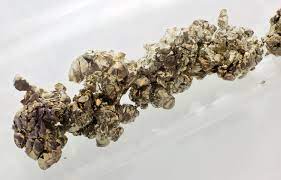Strontium is a chemical element with the symbol Sr and atomic number 38. It is an alkaline earth metal and exhibits several interesting properties.

Here are some key properties of strontium:
Physical properties of strontium
- Appearance: Strontium is a soft, silvery-white metal that oxidizes quickly in air, turning yellowish.
- Density: The density of strontium is about 2.64 grams per cubic centimeter.
- Melting Point: Strontium has a relatively low melting point of 777 degrees Celsius (1431 degrees Fahrenheit).
- Boiling Point: The boiling point of strontium is 1382 degrees Celsius (2520 degrees Fahrenheit).
- State at Room Temperature: Strontium is a solid at room temperature.
Chemical properties of strontium
- Reactivity: Strontium is a highly reactive metal, especially when exposed to air and water. It should be stored under mineral oil or in an inert atmosphere to prevent oxidation.
- Oxidation States: Strontium commonly exhibits a +2 oxidation state, meaning it tends to lose two electrons to form ions (Sr2+).
- Electronegativity: Strontium has an electronegativity of 0.95 on the Pauling scale, indicating a low affinity for electrons.
- Stability: Strontium is stable in dry air but reacts with moist air and water, forming strontium hydroxide and releasing hydrogen gas.
Occurrence and Uses
- Abundance: Strontium is found in the Earth’s crust in various minerals, such as celestite (strontium sulfate) and strontianite (strontium carbonate).
- Fireworks and Pyrotechnics: Strontium compounds, particularly strontium nitrate and strontium carbonate, are used in fireworks and pyrotechnics to produce red colors in flames.
- Medicine and Radiology: The radioactive isotope strontium-89 is used in palliative treatment for the relief of bone pain in certain cancers, as it selectively targets bone tissue.
- Alloys and Metals: Strontium is used as an additive in aluminum alloys to refine grain structure, improve castability, and increase resistance to corrosion.
- Cathode Ray Tubes (CRT): Strontium compounds, such as strontium oxide and strontium carbonate, were historically used in CRT screens due to their ability to emit electrons when heated.
It’s important to note that while strontium exhibits these properties and applications, specific details may vary depending on the source and context. Additionally, the radioactive isotope strontium-90 has notable environmental and health implications due to its long half-life and potential for incorporation into living organisms.